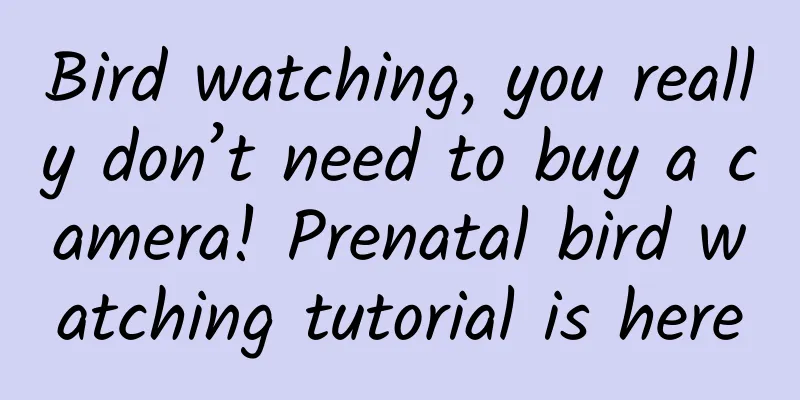Bird watching, you really don’t need to buy a camera! Prenatal bird watching tutorial is here

|
Bird watching has become increasingly popular recently. As the weather warms up, many bird heads appear on trees, roofs and lakes. Even in the city, you can see not only the familiar sparrows, magpies and crows, but also hundreds of other small creatures that are equally lively. Northern Long-tailed Tit, a floating little bird ball! |hajime7212 If you have the urge to go bird watching, but are put off by the sight of the bird photographers in the park all holding a bulky telephoto lens, then this prenatal bird watching guide will take you on a bird watching journey from scratch and help you understand real bird watching. If you are already an entry-level birder, you can also check and fill in the gaps! You can gain this knowledge after reading this article! Essential equipment and drills for bird watching Tips for finding birds in the wild Basic bird identification skills Long guns and short guns are not necessary for bird watching First of all, it should be made clear that bird watching is an activity that takes place in the wild . It is not just about watching the birds, but also their habitats and their behaviors in their natural state. Therefore, going to the zoo or the flower, bird, fish and insect market to watch caged birds cannot be considered bird watching in the strict sense. In addition, bird photography is not the purpose of bird watching, so an expensive camera is not a threshold for bird watching. Long guns and short guns are not necessary | Tuchong Creative Before you set out to go bird watching, you just need to do the following preparations. 1. Select and adjust the telescope A must-have for bird watching is a telescope . Birds have the ability to fly, which makes it difficult for us to see them clearly with our naked eyes. A telescope can help us extend our field of vision, and the quality of the telescope largely determines the bird watching experience. Telescopes are mainly divided into two types: monocular and binocular. The two types of telescopes are applicable in different situations. When watching water birds, due to the wide water surface, a monocular with a larger magnification can be used to see the details of the bird more clearly, and a tripod is required to stabilize the field of vision; when watching forest birds, you will not be far away from the bird, so binoculars are enough, and there is no need for a bulky monocular and tripod. In most cases, a pair of binoculars is a must for bird watching . When choosing a telescope, the two main parameters to consider are magnification and aperture . Take the telescope in the picture below as an example. The number before the multiplication sign represents the magnification, which is usually 8-10 times . The larger the telescope, the darker the field of view and the more severe the shaking. A too small magnification is not conducive to beginners observing details. The second number represents the aperture, which is the diameter of the objective lens. The larger the aperture, the clearer and brighter the image, and the smaller the aperture, the more portable it is . In addition, if you have sufficient funds, you can also choose ED lenses to reduce the impact of dispersion. The magnification and aperture are usually marked near the eyepiece of the telescope. In addition, if you have enough money, you can also choose ED lenses to reduce the impact of dispersion. | Jacek Halicki / Wikimedia Commons After choosing the telescope, can you start bird watching happily? No. For a new pair of telescopes, debugging is an important step . If our eyesight is different, we need to fine-tune the other eye based on the dominant eye. In addition, we need to adjust the angle between the left and right sides according to the distance between the eyes, so that the independent images from the left and right sides converge into a circle to obtain the best observation effect. Adjusted eye distance | birdwatching.com Finally, let's practice how to use a telescope to quickly observe a lively bird - first, stare at a target object in the distance (don't look at other people's homes), then keep your sight in the same direction, hold the telescope with both hands, and quickly raise it to your eyes . At this time, is the target object still in front of you? 2. Prepare a "one-page" illustration book Bird watching is of course inseparable from an atlas . It not only provides "preview" information - allowing us to get to know the birds we want to observe in advance, but also helps us identify unfamiliar bird species and deepen our impressions. Specific recommended atlases can be found at the end of this article. If it is inconvenient to carry an illustrated guide with you, you can also use mobile phone software or web pages to get detailed introductions and high-definition pictures of a certain bird species. Some software even has image recognition and voice recognition functions, such as " Know Birds ", which can help us identify 80% of unfamiliar bird species. Of course, this is when there is an Internet connection and clear pictures are taken. "Know Birds" applet page|Know Birds Your bird-identifying skills will naturally improve as you read more books, practice more in the wild, and hang out with more experienced bird watchers. 3. Prepare bird species in advance Before setting off, it is best to find out what birds are at your destination and whether you can see them in the current season, so as not to return disappointed. The most direct way is to search online, such as the website or applet of the " China Bird Watching Record Center ". You can click on your city to check the number of bird species|China Bird Watching Center Many birds have the habit of migration . It is definitely not a wise choice to go to the places where birds spend the winter during the breeding season to look for them. Similarly, if you want to observe new bird species, you don’t have to go far away. You just need to learn more about their migration dates (check in the atlas or on the website), and you will always meet one or two of them. Knowing the birds at your destination will make you more confident when identifying them in the wild. In the "Query Statistics" column of the China Bird Watching Record Center, you can choose to query records by observation time, which is convenient for us to understand the birds in different seasons at a certain bird watching point|China Bird Watching Center If you don't have a destination yet, then Baidu the bird watching spots in our area. For beginners, wetland parks and forest parks around the city are a good choice - the route is easier, the habitat types are rich, and the diversity of birds is often not low. After getting familiar with these birds that often appear around the city, and having accumulated a certain amount of bird watching experience, you can go further to remote bird watching spots to feast your eyes. Can't even see a single feather when watching birds in the wild? There is a trick! When we have made all the preparations and enthusiastically arrive in the wild, we may not even see a feather of a bird, or we may watch them fly quickly past our field of vision and disappear before we even raise the telescope. Usually, the appearance of birds in the wild is not exactly the same as in the illustrated book, but it has nothing to do with it. Hopefully, the following tips will help you find and recognize more birds more easily. Choose a good location Some passerine birds like to stand on the treetops to " watch people", and relatively low power lines can also become meeting places for birds. You are also likely to see birds near ponds or banks , such as passerines bathing, kingfishers and wading birds foraging. In addition, you can also pay attention to the edges of woods or bushes. There are always surprises on the wires | Jianer Choose the right time Timing is important for bird watching. Most birds are most active within an hour after sunrise . If you are lucky, just stand still and wait. Sometimes, small passerine birds will fly over the branches in front of you in waves, and each wave is a mixed group of several species of birds. This is the legendary "bird wave". If you can't get up at 5 or 6 in the morning, that's OK, as long as the location is right, you can observe birds at any time of the day. In addition, birds usually have a peak activity before sunset. A mixed flock of several small birds suddenly appeared before my eyes, and then disappeared immediately, but the next wave was on the way | Jianer Are all black birds crows? How to identify birds When you first start bird watching, you might think that all the grey birds are sparrows and all the black birds are crows. If you want to be an expert at bird identification, reading the appearance characteristics in the illustrations is essential, but you don't have to remember all the descriptions. These tips can help you easily and quickly identify birds in the wild! There are many ways to identify birds in the wild. When the bird is relatively common, it is easiest to identify it by its most critical features , such as its unique appearance . By identifying the distribution of feather colors, special feathers, tail shape, beak shape, and the presence of crests, you can immediately determine what kind of bird it is. For example, the "name-as-it-is" mallard and red-eared bulbul, the bone-crested pheasant with a white forehead and beak, and the hoopoe with black and white striped wings and exaggerated crests... Mallard (upper left), Red-eared Bulbul (upper right), Coot (lower left), Hoopoe (lower right) | flickr Unfortunately, most birds do not have features that can be identified at first glance, and many passerine birds are too similar. In this case, it is easier to first determine which "group" it belongs to , and then identify the bird species. If you encounter an unfamiliar bird, you can also index it in the atlas in this way. To distinguish birds from different groups, you can also grasp the most critical characteristics. For example, if you look closely at the shape of the beak , you can easily tell that the blackbird in the left picture is a blackbird, not a crow, because corvids have thicker and more powerful beaks. Corvidae have thicker beaks | wikipedia The dazzling array of passerine birds can also be distinguished by their beaks: the beaks of warblers appear to be slender, those of tits are small relative to their bodies, those of finches are short and thick, and those of waxbills are larger. Golden-headed Leaf-Tailed Warbler (upper left), Green-backed Tit (upper right), Black-headed Goldfinch (lower left), Black-tailed Grosbeak (lower right)|Jian'er In addition to its distinctive appearance, its call, behavior, habitat, distribution range, and even the posture when resting on a branch can help in making an identification. When birds are flying is also a good time to identify them . Although both are wading birds, herons shrink their necks when flying, while cranes do not; the unique way woodpeckers flap their wings makes them appear to fly in a wavy shape; different wing flapping frequencies can also be used as a basis for differentiation. Top: egret in flight; bottom: grey crane in flight | John Queen, praveen pandian / flickr Different birds have their own favorite habitats . For example, thrushes and pigeons like to walk on the ground, woodpeckers like to climb on tree trunks, various tits like to gather in the tree canopy, and some crows often appear in the bushes. A little more difficult, when easily confused species appear at the same time, you can use their relative differences to distinguish them . For example, when the Great Egret, the Intermediate Egret, and the Little Egret appear at the same time, you can quickly identify them by their size differences, and you can easily distinguish the Grey Heron next to them by the difference in feather color. The feather colors of herons and great egrets are significantly different (the blurry version simulates long-distance bird watching, haha) | Jianer When these similar bird species are not in the same frame, bird watchers are more required to control the details - the key point to identify the great egret is that its beak is split across the eyes, while the most obvious sign of the little egret is their yellow toes, and the biggest difference between them and the cattle egret is that one has a black beak and the other has a yellow beak. No prize guessing game: Let’s identify various egrets now! | Wikipedia You can also look at the proportions of the body parts . Some have big beaks, some have long tails, and some are round. This is very important in the identification of birds of prey . Paying attention to the wingspan of birds of prey, the length of the tail, and the proportion of the head to the body can help distinguish the various groups. The tail of the long-tailed tit (left) is longer than its body, while the tail of the chickadee (right) is shorter than its body. However, sometimes the same bird species can have different feather colors due to differences in gender, age, or whether it is in the breeding season . The key to identifying them is to observe the unchanging features such as the beak, iris, and tarsus. Can you still recognize a mallard duck if its head isn't green? | Heather Paul / birdnote In short, there are countless ways to help us identify birds. In the early stages of bird watching, these skills will overwhelm you like a tide. Don't worry, as long as you watch more, compare more, and think more , you will soon master these bird identification skills. In the process of learning bird watching, don't be afraid to identify because of fear of making mistakes. If someone else says the correct bird species, comparing the differences between the two birds in the illustration is also a great learning opportunity. Finally, here are some recommended books and websites, hoping they can be helpful to those who are just getting started. 1. A must-have birdwatching guide: China Bird Field Guide (New Edition by Ma Jingneng) 2. An extremely detailed bird watching guide, The Sibley Birding Guide 3. A comprehensive guide to identifying birds based on their behavior: Bird Behavior Atlas 4. China Bird Watching Record Center https://www.birdreport.cn/ (also has a mini program, very convenient to use) 5. Cornell Lab of Ornithology’s bird watching website https://ebird.org/home 6. World Bird Database https://avibase.bsc-eoc.org/avibase.jsp 7. "Know Birds" applet Author: Jian Er Editor: Little Towel, Mai Mai |
<<: Is corporal punishment really good? | International Day Against Hitting Children
Recommend
iPad Pro review: Switch to iPad Air 2
Two days ago, there was news that the iPad Pro sol...
What a wonderful bird with a singing voice that calls the morning light and red ears that chirp!
A bird's eye view of science Quanzhou Associa...
Don't buy them anymore! Cartoon-shaped hand warmers are not up to standard!
Electric hot water bottles, rechargeable hand war...
Xiaohongshu User Operation Strategy Analysis Report
Xiaohongshu is a representative example. There ar...
Behind the Android 12 upgrade: a decade of struggle between Android and Apple systems
Although Android still has many problems, it is u...
How to activate the 400 customer service phone number? What are the application procedures for the 400 phone number?
How to activate the 400 customer service phone nu...
New clues have been added to the "origin of the moon". Where did this mysterious planet come from?
How was the Moon formed? The most mainstream hypo...
Hello everyone! I am the "King of Snow Mountain"
recent A six-month-old snow leopard refused to le...
Dutch scientists propose opening a robot red-light district by 2050
In the setting of "Ghost in the Shell",...
The algorithm recommendation mechanism of Toutiao and Douyin is not as "stupid" as people say on the Internet!
In 1865, on the flat land outside Yongdingmen in ...
It is difficult to charge new energy vehicles, and charging pile operating companies are powerless. Who will break this vicious cycle?
In recent years, due to the use of ternary batter...
How to evaluate, monitor and promote KOL marketing channel conversion?
With the rapid development of the Internet , we h...
Apple's Tian Ji horse racing, iPhone 14 inventory may reach 95 million units, domestic brands are under severe pressure
When Apple started playing the Tian Ji horse raci...
[Exercise Prescription] Exercise is the best medicine! How to exercise for 9 diseases?
Doctors prescribe drugs to patients, and everyone...









